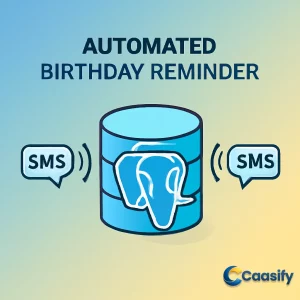Introduction
Creating automated birthday reminders with PostgreSQL, Twilio, and Python is a powerful way to streamline notifications. By combining a PostgreSQL database with Twilio’s SMS capabilities, you can easily automate birthday reminders for your contacts. This tutorial walks you through the process of setting up the necessary environment, writing a Python script to query the database for matching birthdays, and sending SMS notifications. With these tools, you’ll build a fully functional and practical birthday reminder service that runs automatically.
What is Birthday Reminder Service?
This solution allows you to automatically check a database for birthdays on a given day and send SMS reminders to the user. It combines a database query to find matching birthdays with the use of an SMS service to notify the user via text message, making it a practical tool for remembering important dates.
Step 1
Install Twilio’s Python SDK
Imagine this: you want to get a text message every time someone on your contact list has a birthday. Sounds awesome, right? To make that happen, we need to install Twilio’s Python library. It’s super simple—just open your terminal and run this command:
$ pip install twilio
If you don’t have your Twilio credentials yet, don’t worry, it’s easy to get them. Just head over to Twilio’s Messaging Quickstart guide, and it’ll walk you through signing up, buying a phone number, and grabbing the credentials you need (Account SID, Auth Token, and a phone number). These credentials are essential for sending the SMS notifications.
Step 2
Update Your .env File
Now that Twilio is all set up, let’s configure your environment. You’ll need to update your .env file to store your database credentials (from Day 2) and Twilio credentials safely. This file is where all your sensitive information goes, so keep it private!
Here’s what your updated .env file should look like after adding your credentials:
# Database credentials
DB_HOST=<your-database-hostname>
DB_NAME=<your-database-name>
DB_USER=<your-database-username>
DB_PASSWORD=<your-database-password>
DB_PORT=5432 # Default PostgreSQL port# Twilio credentials
TWILIO_ACCOUNT_SID=<your-twilio-account-sid>
TWILIO_AUTH_TOKEN=<your-twilio-auth-token>
TWILIO_PHONE_FROM=<your-twilio-phone-number>
TWILIO_PHONE_TO=<your-personal-phone-number>
Make sure to replace the placeholders with your actual credentials, especially the personal phone number for TWILIO_PHONE_TO—that’s where the notifications will go.
Pro Tip: Don’t forget to add .env to your .gitignore file! This is important to keep your credentials from being exposed when you use version control systems like Git.
Step 3
Write the Python Script
Now the fun part starts! With everything set up, let’s get into the Python script that will bring this whole process to life. Here’s what the script will do:
- Connect to your PostgreSQL database.
- Look through your contacts and find birthdays that match today.
- If it finds any, send you a text to let you know about the birthday!
Here’s what the script looks like:
# check_birthdays.py
from datetime import datetime
import pg8000
from dotenv import load_dotenv
from twilio.rest import Client
import os# Load environment variables
load_dotenv()def connect_to_database():
“””Establish connection to the database.”””
return pg8000.connect(
host=os.getenv(“DB_HOST”),
database=os.getenv(“DB_NAME”),
user=os.getenv(“DB_USER”),
password=os.getenv(“DB_PASSWORD”),
port=int(os.getenv(“DB_PORT”))
)def send_birthday_message(first_name, last_name):
“””Send a birthday text message using Twilio.”””
try:
# Twilio setup
account_sid = os.getenv(“TWILIO_ACCOUNT_SID”)
auth_token = os.getenv(“TWILIO_AUTH_TOKEN”)
client = Client(account_sid, auth_token)
# Compose the message
message = client.messages.create(
body=f”? It’s {first_name} {last_name or ”}’s birthday today! ?”,
from_=os.getenv(“TWILIO_PHONE_FROM”),
to=os.getenv(“TWILIO_PHONE_TO”)
)
print(
f”Message sent to {os.getenv(‘TWILIO_PHONE_TO’)} for {first_name} {last_name or ”}. Message SID: {message.sid}”
)
except Exception as e:
print(f”An error occurred while sending the message: {e}”)def check_birthdays():
“””Check if any contact’s birthday matches today’s date and send a notification.”””
try:
conn = connect_to_database()
cursor = conn.cursor()
# Get today’s month and day
today = datetime.now()
today_month = today.month
today_day = today.day
# Query to fetch contacts whose birthday matches today’s date
cursor.execute(
“””
SELECT first_name, last_name, birthday FROM contacts WHERE EXTRACT(MONTH FROM birthday) = %s AND EXTRACT(DAY FROM birthday) = %s;
“””,
(today_month, today_day)
)
rows = cursor.fetchall()
# Notify for each matching contact
if rows:
print(“Birthday Notifications:”)
for row in rows:
first_name, last_name, _ = row
send_birthday_message(first_name, last_name)
else:
print(“No birthdays today.”)
# Close the cursor and connection
cursor.close()
conn.close()
except Exception as e:
print(f”An error occurred while checking birthdays: {e}”)if __name__ == “__main__”:
check_birthdays()
Here’s how it works:
- connect_to_database() : This function connects to your PostgreSQL database where all the birthdays are stored.
- send_birthday_message() : This is the function that actually sends the SMS through Twilio whenever it finds a birthday.
- check_birthdays() : This checks the database for any birthdays that match today’s date and sends out the SMS.
Once you run the script, it will go through your contacts, check for birthdays today, and send a text message for each one it finds.
Step 4
Test Your Script
Now, let’s get to the fun part—testing the script! To make sure everything is working as it should, just run the following command in your terminal:
$ python check_birthdays.py
If there’s a birthday in your database that matches today’s date, you’ll get an SMS notification! ? If there’s no match, the script will print out: “No birthdays today.” This is an easy way to check and make sure everything is running smoothly.
Conclusion
In conclusion, using PostgreSQL, Twilio, and Python together is a powerful solution for automating birthday reminders. By following this guide, you can create a practical, fully functional reminder service that checks for birthdays in your database and sends SMS notifications automatically. With clear steps for setting up the necessary tools, including Twilio for SMS integration and Python for script automation, you now have the knowledge to build a seamless birthday reminder system. As automation continues to grow in importance, this kind of solution offers endless possibilities for streamlining repetitive tasks. Stay ahead by exploring other use cases for PostgreSQL, Twilio, and Python to automate even more aspects of your daily workflow.
Master Python Programming: A Beginner’s Guide to Core Concepts and Libraries (2025)

